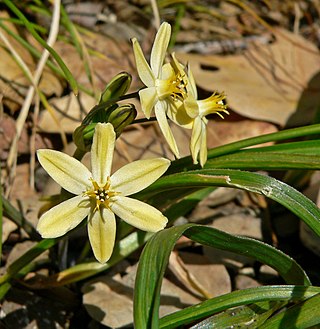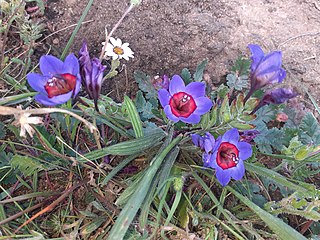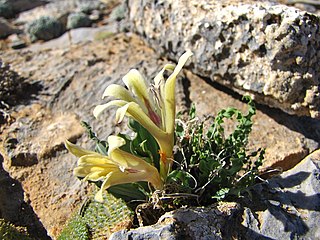
Babiana is a genus of geophytes in the family Iridaceae with 93 recognized species as of March 2022. The leaves consist of a stalk and a blade that are at an angle to each other. The leaf blades are entire, laterally flattened and pleated, and often hairy. Each individual flower is subtended by two hairy or smooth bracts that are green in most species. The outer bract is often the largest of the two. In most species the bracts have a dry, brown tip, but in a few species it is entirely green or entirely dry when flowering or the outer bract is translucent and has a papery texture. The inner bract is forked or split all the way to its base. Each flower is without a pedicel, with six tepals that are merged at their base into a tube and form a perianth that is mirror-symmetrical in most species, with three anthers implanted where the perianth tube widens and that are, in almost every species, clustered at one side of the style. The style has three branches that widen towards the tip and the ovary is inferior. Flowers occur in almost every conceivable colour, many have markings on some of the tepals, and few star-symmetrical flowers have a centre that strongly contrasts with the free part of the perianth. The majority of these species are endemic to the west and southwest of South Africa, and southwestern Namibia, but one species occurs elsewhere in Namibia and South Africa and another species can be found in Botswana, Namibia, South Africa, Zambia and Zimbabwe. The genus name is derived from the Dutch word baviaan, referring to the Chacma baboon, Papio ursinus, that consumes the corms of plants in the genus. The genus is called bobbejaantjie in Afrikaans, meaning small baboon.

Triteleia ixioides, known as prettyface or golden star, is a monocotyledon flowering plant in the genus Triteleia. It is native to northern and central California and southwestern Oregon, where it can be found in coastal and inland coniferous forests and other habitat. It is a perennial wildflower growing from a corm. It produces one to two basal leaves up to 50 centimeters long by 1.5 wide. The inflorescence arises on an erect stem up to 80 centimeters tall. It is an umbel-like cluster of several flowers each borne on a pedicel up to 7 centimeters long. The flowers are variable in size, measuring one to nearly three centimeters in length. They are pale to bright yellow, or sometimes purple-tinged white. There are six tepals with darker midveins in shades of green, brown, or purple. The lobes are funnel-shaped and may open flat or somewhat reflexed. The six stamens form a fused tube that protrudes from the corolla; they have broad, flat filaments and whitish, yellowish, or blue anthers.

Babiana ambigua is a species of plant in the Iridaceae. It is endemic to the Western Cape province of South Africa. It is a geophyte, that appears from an underground corm every year and grows to a height of 5–8 cm (2.0–3.1 in) or occasionally up to 16 cm (6.3 in). Its leaves are pleated, hairy, lance-shaped, reaching higher than the inflorescence. The fragrant, mirror-symmetric, blue to mauve flowers, consist of six tepals merged into a tube at their base, but with free lobes at the top. The lower lateral tepals have whitish markings accentuated by a more intense blue line along their margin. Each flower is supported by two green bracts sometimes with a brownish tip, and the inner bract is divided entirely to its base. There are three anthers crowded to the dorsal side of the perianth and a style divided in three branches on top of a smooth ovary. Flowers can be found from late July at sea level to the end of September at high altitude.

Barberetta is a genus of herbaceous perennial plants in the family Haemodoraceae. It contains only one known species, Barberetta aurea.

Dilatris is a genus of four species of evergreen perennial herbaceous plants of up to 60 cm (2.0 ft) high, that are assigned to the bloodroot family. The plants have hairless, line- to lance-shaped leaves set in a fan that emerges from a red or orange coloured rootstock. Six free tepals with some gland dots near their tips are present on the mauve or dirty yellow flowers' six free petals. The other two stamens are longer and spreading with smaller scarlet anthers, while the one stamen is short, upright, and has a large, yellow anther. The style is diverted from the centre opposite both longer stamens. The species only occur in the Western Cape and Northern Cape provinces of South Africa.

Romulea sabulosa is a perennial geophyte that is assigned to the family Iridaceae. It has a few grooved thread-like leaves, and relatively large burgundy red trimerous flowers, reminiscent of crocus flowers, with yellow to light greenish with black markings and stamens with light green free filaments. It only occurs on sandy clay on renosterveld west of Nieuwoudtville in the Northern Cape province South Africa. It is called satynblom in Afrikaans.

Romulea tortuosa is a herbaceous perennial geophyte in the family Iridaceae native to South Africa. It has a small corm in the soil, a few prostrate coiling leaves, and fragrant, trimerous yellow flowers, sometimes with six brown blotches on the inside near the bottom of the flower.

Romulea monadelpha is a herbaceous perennial geophyte in the family Iridaceae native to South Africa. It has a small corm in the soil, a few thread-like leaves, and trimerous dark red flowers with elaborate markings on the inside near the bottom of the flower. It is called karoo satynblom in Afrikaans.

Romulea columnae, the sand crocus, is a herbaceous perennial in the family Iridaceae. It is a small plant, with thin narrow leaves, and small scape which has small pink, pale purple or violet pointed flowers with darker veining and a gold or yellow throat. It is native to a wide area ranging from western Europe to the Mediterranean.

Wachendorfia brachyandra is a small to large, 10–65 cm (3.9–25.6 in) high, winter-growing, perennial herbaceous plant that grows from a rootstock, and has been assigned to the bloodroot family. Its simple, entire, line- to lance-shaped leaves that are usually shorter than the stem, and have pleated, laterally flattened leaf blades af about 35 mm (1.4 in) wide, meaning that there are left and right surfaces rather than upper and lower. The inflorescence is a lax panicle and at the base of each flowerstalk is a dry, brown and papery bract, and those higher in the panicle have a recurved tip. The mirror-symmetrical pale apricot-yellow flowers consist of six tepals and are adorned with brown markings on the upper three tepals. There are three anthers that are clustered and about half as long as the tepals. Each individual flower only lasts one day. Flowering occurs from August to December. This species grows in the wild in the Western Cape province of South Africa only, and is much less common than its relatives W. paniculata and W. thyrsiflora. It is sometimes called short-stamen butterfly-lily in English.

Babiana lobata is a species of geophyte of 12–25 cm (4.7–9.8 in) high that is assigned to the family Iridaceae. It has leaves that consist of a sheath and a blade that are at a slight angle with each other. The leaf blades are narrow, sword- to lance-shaped and have a left and right surface, rather than an upper and lower surface. The leaf blades are slightly pleated and hairless. The inflorescence contains seven to twelve bluish mauve mirror-symmetrical flowers comprising six tepals, with the lower lateral tepals yellow sometimes flushed mauve at their tips, and with three stamens crowding under the dorsal tepal. Flowering occurs in July and August. The flowers emit a faint acrid-metallic scent. B. lobata grows in part of the Richtersveld in the Northern Cape province of South Africa.

Babiana bainesii is a species of geophyte of 15–25 cm (5.9–9.8 in) high that is assigned to the family Iridaceae. It sometimes grows in tufts. The approximately upright leaf blades appear directly from the ground, are narrow, sword- to line-shaped and have a left and right surface, rather than an upper and lower surface, and far exceed the flowers in length. The leaf blades are pleated. The inflorescence stem is fully underground and often branched. It contains two to eight blue, violet or mauve mirror-symmetrical flowers comprising six tepals. B. bainesii has a wide distribution and occurs in Botswana, Namibia, South Africa, southernmost Zambia and Zimbabwe.

Babiana villosa is a species of geophyte of 10–20 cm (3.9–7.9 in) high that is assigned to the family Iridaceae. It has mauve-pink, purple or scarlet star-symmetrical wide chalice-shaped flowers with narrow tube, large, blackish or dark purple anthers, and velvety hairy, lance-shaped, laterally compressed leaves, set in a fan. Flowers occur during August and September. It grows between Malmesbury and Wellington in the Western Cape province of South Africa. It is commonly called red babiana in English and rooibobbejaantjie in Afrikaans.

Babiana hirsuta is a species of geophyte of 40–70 cm (16–28 in) high that is assigned to the family Iridaceae. It has many scarlet mirror-symmetrical flowers in a branched inflorescence with several short ascending branches. The flower has a narrow tube, and three large, blackish or dark purple anthers that extend beyond the dorsal tepal. The leaves are velvety hairy, lance-shaped, laterally compressed and set in a fan. It is an endemic species of South Africa that can be found along the west coast of the Northern and Western Cape provinces as far south as Saldanha. It is called red babiana in English, but that name is also applied to Babiana villosa, and strandlelie, sandlelie and rooihanekam in Afrikaans. Until 2008, the strandlelie was known as Babiana thunbergii.

Babiana rubrocyanea is a perennial geophyte of 5–15 cm (2.0–5.9 in) high, with entire, lance-shaped, hairy, pleated leaves and flowers that have a narrowly funnel-shaped tube at their base and six free tepal lobes at the top that form a wide cup that is purplish blue with a sharply defined carmine red centre. It can be found in a small area of the Western Cape province of South Africa. Flowers can be found from August to the middle of September. It is called blue-and-red babiana in English and rooibloubobbejaantjie in Afrikaans.

Babiana scabrifolia is a perennial plant of 5–15 cm (2.0–5.9 in) high that annually forms leaves and flowers from an underground corm and is assigned to the Iris family. It produces relatively large, pale lilac or blue flowers slightly above the soil, and soft, lightly pleated leaves that reach beyond the flowers. These leaves are lance-shaped to oblong in adults, but line-shaped and twisted in non-flowering specimens. Flowering occurs from June to August. The species can be found in the Western Cape province of South Africa.

Babiana pygmaea is a perennial plant of about 10 cm (3.9 in) high that annually forms leaves and flowers from an underground corm that is assigned to the iris family. It has bowl-shaped, pale yellow flowers with six perianth lobes, purplish in its heart, emerging from a cylindrical tube, and lance-shaped, pleated and heary leafblades that are almost at a right angle with the sheaths. The species can be found in the Western Cape province of South Africa. It is called geelbobbejaantjie in Afrikaans.

Babiana cinnamomea is a perennial plant of about 4–6 cm (1.6–2.4 in) high that annually forms leaves and flowers from an underground corm that is assigned to the iris family. It has inconspicuous pale greenish yellow flowers and broad, hairless, pleated leaves with undulating margins. Flowers may be found in May and June. It occurs in the very north of the Western Cape province of South Africa.

Babiana hypogaea is a perennial plant of about 5–8 cm (2.0–3.1 in) high that annually forms leaves and flowers from an underground corm that is assigned to the iris family. It has pale greenish yellow, buff or rarely white, mirro-symmetrical flowers and line- to sickle-shaped, slightly pleated, thinly hairy or hairless leaves that are held horizontally or inclined, that grows in the summer rainfall areas of southeastern Namibia and central and northern central South Africa. Flowers may be found between June and September and sometimes between December and May. It is called Bobbejaankalkoentjie, Bobbejaanuintjie or Ertappeluintjie in Afrikaans.

Babiana mucronata is a perennial plant species that grows to about 5–18 cm (2.0–7.1 in) high and annually forms leaves and flowers from an underground corm. It is assigned to the iris family. It has a simple or branched, more or less upright spike of 3-12 dark to pale violet-blue, mirror-symmetrical flowers. Each flower consists of a perianth that is merged below into a funnel-shaped tube of 10–25 mm (0.39–0.98 in) long but splits into six unequal tepals. Three stamens are curved, crowded near the upper lip, and carry pale violet anthers. Flowers may be found between late July and September.





















